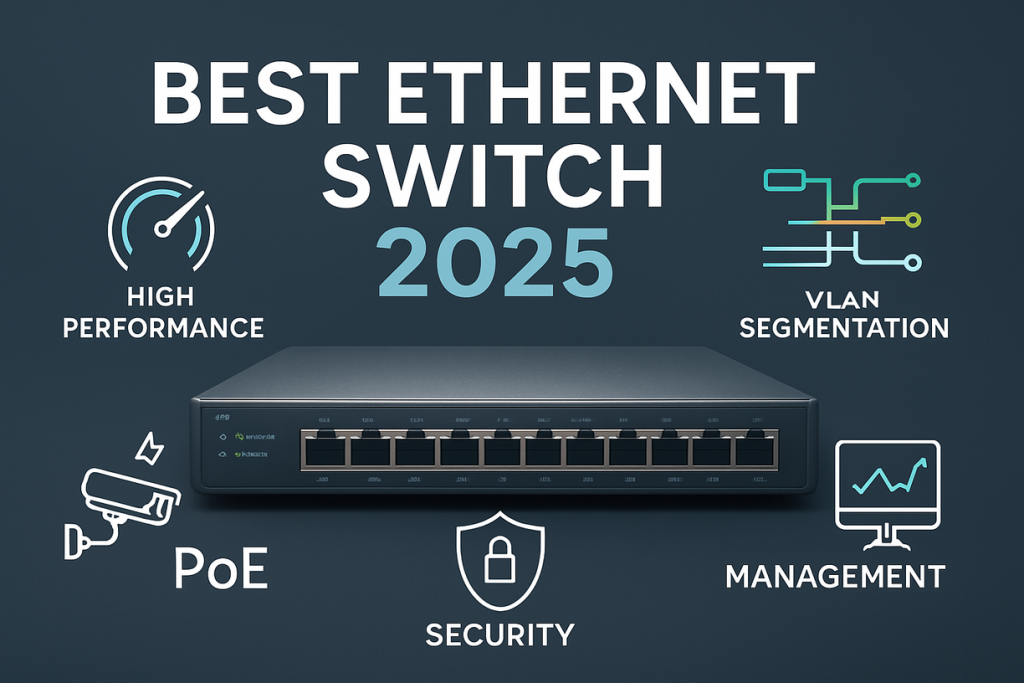Selecting the right Ethernet switch for your business network is critical to ensuring optimal performance, security, and scalability while avoiding costly future upgrades and network downtime. This guide helps you understand the types, features, and best brands of Ethernet switches for SMBs and enterprises in 2025.
Why Choosing the Right Ethernet Switch Matters
Your Ethernet switch is the backbone of your business network, connecting PCs, servers, IP cameras, and other devices. Choosing the wrong switch can result in:
- Network congestion and slow data transfers
- Increased security risks
- Limited scalability and flexibility
- Higher maintenance and upgrade costs
By selecting the right Ethernet switch, you can build a network that is efficient, secure, and ready for future expansion.
Key Factors to Consider When Choosing an Ethernet Switch
1. Port Count and Speed
- Port Count: Assess the current devices you need to connect and allow room for growth. Small offices may require 5–8 ports, while larger deployments may need 24–48 ports.
- Speed: While 1Gbps is standard, consider 2.5G/5G/10G ports if your business handles large file transfers, video conferencing, or cloud applications to prevent bottlenecks.
- SFP/SFP+ Uplinks: Useful for fiber backbone connections or long-distance uplinks.
2. Power over Ethernet (PoE) Capability
PoE switches deliver both power and data over a single Ethernet cable, simplifying cabling for devices like IP cameras, wireless access points, and VoIP phones, especially in environments with limited power outlets.
- Check the total PoE power budget and per-port wattage (PoE+ typically supports up to 30W per port).
- Advanced PoE switches may include auto-recovery to reboot unresponsive devices remotely.
3. Managed vs. Unmanaged Switches
| Feature | Managed Switch | Unmanaged Switch |
|---|---|---|
| Configuration | Customizable (VLAN, QoS, security) | Plug-and-play, no configuration |
| Security | Advanced (802.1X, ACLs) | Basic physical security only |
| Monitoring | Supports SNMP, remote monitoring | Not supported |
| Use Case | Networks requiring control and security | Home offices, small networks |
| Price | Higher | Lower |
| Scalability | Stacking, VLAN segmentation supported | Limited scalability |
4. Scalability
For growing businesses, stackable switches enable you to add capacity while maintaining unified management.
5. Design and Environmental Factors
- Fanless Design: Ideal for quiet offices.
- Mounting Options: Desktop, rack-mounted, or wall-mounted.
- Industrial Options: Rugged models for warehouses or factories.
Recommended Ethernet Switches by Use Case
| Scenario | Recommended Models | Notes |
|---|---|---|
| Budget/Basic Connectivity | TP-Link TL-SG105D, NETGEAR GS305, TP-Link TL-SG1016 | Simple, cost-effective unmanaged switches |
| PoE Device Deployments | TP-Link TL-SG166P, NETGEAR GS324P, TRENDnet 8-Port PoE+ | Power IP cameras, APs, VoIP phones |
| Managed Networks | Cisco CBS220, TP-Link TL-SG3210XHP-M2 | VLAN, QoS, remote management |
| High-Performance/Data Center | Cisco Catalyst 9300, Arista, Juniper EX, Aruba CX | Large-scale, high-traffic networks |
Specific Model Recommendations
1.Budget-Friendly and Basic Connectivity
- TP-Link TL-SG105D (5-Port Gigabit Unmanaged)
- NETGEAR GS305 (5-Port Gigabit Unmanaged)
- TP-Link TL-SG1016 (16-Port Gigabit Unmanaged)
- NETGEAR JGS524 (24-Port Gigabit Unmanaged)
2.For PoE Device Deployments
- TP-Link TL-SG166P (16-Port Gigabit PoE+)
- NETGEAR GS324P (24-Port Gigabit PoE+)
- TRENDnet 8-Port Long-Range PoE+ Switch
3.High-Performance and Managed Networks
- TP-Link TL-SG3210XHP-M2 (2.5G PoE+ Managed)
- Cisco CBS220-24T-4G (24-Port Gigabit Managed)
- Cisco CBS350-8MGP-2X (Managed PoE)
- Cisco Catalyst C1300 Series (Gigabit/2.5G with PoE)
4.Enterprise and Data Center
- Cisco Catalyst 9300/9500 Series
- Arista 7050X/720XP Series
- Juniper EX Series
- HPE Aruba CX Series
FAQs
Q1: Which Ethernet switch is best for business?
It depends on your needs. For small offices, unmanaged Gigabit switches from TP-Link or NETGEAR are ideal. For advanced control, Cisco CBS managed switches excel. For enterprise networks, consider Cisco Catalyst or Arista.
Q2: Are PoE switches worth it?
Yes, PoE switches simplify cabling by delivering power and data over one cable, ideal for powering IP cameras, APs, and VoIP phones.
Q3: What is the fastest Ethernet switch speed available?
While 1Gbps is common, switches with 2.5Gbps, 5Gbps, 10Gbps, and even 100Gbps are available for data-heavy environments.
Q4: How do I choose a network switch for a home office?
A 5 or 8-port unmanaged Gigabit switch like the TP-Link TL-SG105 is sufficient. For PoE needs, consider a small PoE+ switch.
Conclusion
Choosing the right Ethernet switch ensures your network remains efficient, secure, and scalable. Whether you need a plug-and-play device or an advanced managed PoE+ switch, router-switch offers a comprehensive range of options from trusted brands like Cisco, Huawei, NETGEAR, and TP-Link. If you need personalized recommendations for your deployment, our team is ready to assist with tailored advice to ensure you get the best switch for your network.





